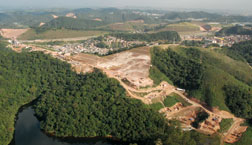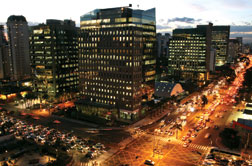The motto of the Brazilian city of São Paulo translates as “I am not led, I lead,” but on the streets of the sprawling metropolis it has become increasingly hard to get anywhere at all. The population of greater São Paulo is nearing 20 million residents, making it the seventh-largest metropolitan area in the world. The increasing population and boom in business has overloaded the city’s transportation infrastructure, making relatively short jaunts into nightmares of endurance. More than 6 million vehicles clogged the city’s streets last year, making movement through major routes and popular side streets almost impossible at peak periods.
 odebrecht Beltway route cuts through forest near city reservoir, raising environmental concerns.
|
The scope of the problem is evident on the roof of every major building: Helicopter pads have become commen features of the city’s skyline. According to a recent story in the Guardian newspaper, São Paulo’s fleet of 469 helicopters is now the largest of any city in the world.
To address the situation, the government is moving on two massive infrastructure projects: upgrading the city’s public transportation system and construction of an immense highway ring around the metropolitan area.
The Metrô de São Paulo saw its ridership jump almost 9% last year to a record 919 million—an average of 3.23 million people every day. The surge in passengers began in 2005 when state government integrated the CPTM system of subway trains with the city’s bus system. Between 2004 and 2007 the number of riders increased more than 30%.
Yet the system remains woefully limited, with only slightly more than 81 kilometers of track. Completion of the Line 4 project as well as other improvements will extend the length to 240 km by the end of 2010.
The Line 4 project is one element of a $10.5-billion effort to upgrade the entire public transportation system. The 12.8-km-long subway, also known as the Yellow Line, is being built by Consórcio Via Amarela, comprising Brazilian firms Odebrecht, OAS, Queiroz Galvão, Camargo Correa and Andrade Gutierrez.
The $1.4-billion project suffered a severe setback in January 2007 when the excavation of the Pinheiros station suddenly collapsed. Seven people died when pedestrians and drivers on the nearby street were sucked into the hole.
 C.J.Schexnayder / ENR In metropolitan Sao Paulo, population 20 million with 6 million vehicles, traffic jams extend well beyond rush hour.
|
The cause of the accident is still the subject of an investigation by the Instituto de Pesquisas Tecnológicas do Estado. Discussions on remuneration between the consortium and the state government will not be completed until that report is finalized, officials say.
At Pinheiros station, the area of the collapse has been re-excavated and extensive reinforcement measures implemented. A system of tie-backs extending 32 meters into the soil has been installed.
In addition, there have been difficulties obtaining property to allow access to the job that has pushed back the effort in that 5.3-km section of the project. Earlier this year, the consortium sought $165 million from owner Metrô of Sao Paulo for construction change orders. The request is pending.
The first phase was originally slated for completion last June but various difficulties have pushed that back to November of next year. The second phase should be completed in 2010.
A 5.3-kilometer section, running from the train yard under the river to just beyond Pinheros station, was built using the New Austrian Tunneling Method. A 6.5-km stretch from there to the terminus is being bored with a Herrenknecht-built, 9.5-m-dia, earth-pressure balance-shield tunnel-boring machine. It is the largest TBM in Latin America, according to the consortium.
The machine has reached the halfway point of its task and will begin boring the last 3 km this summer. So far it has averaged about ...
 Related Links:
Related Links: 
Post a comment to this article
Report Abusive Comment